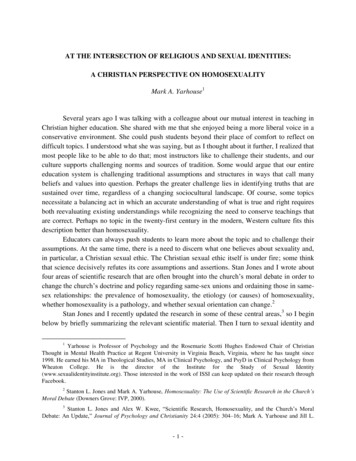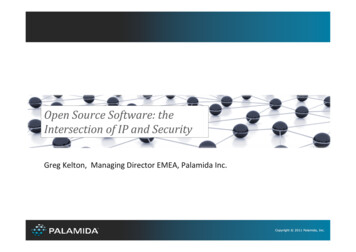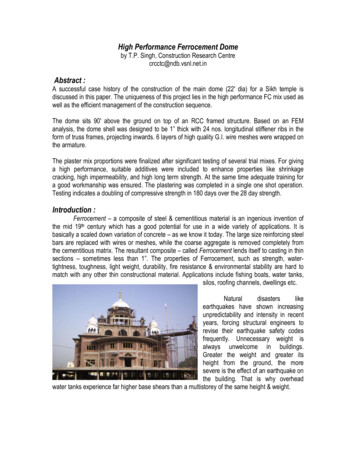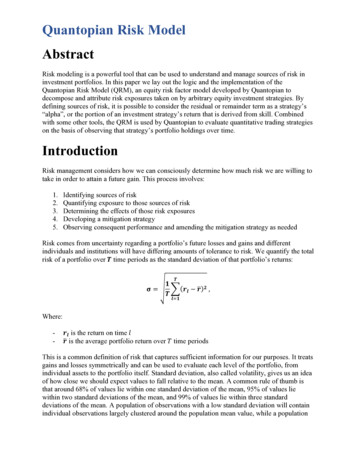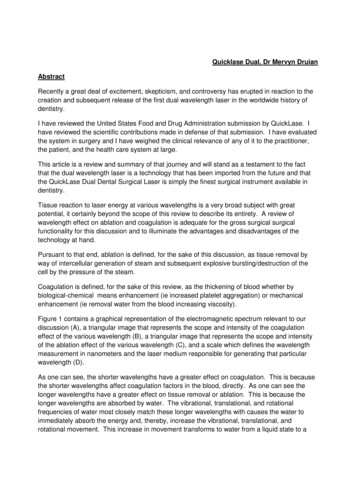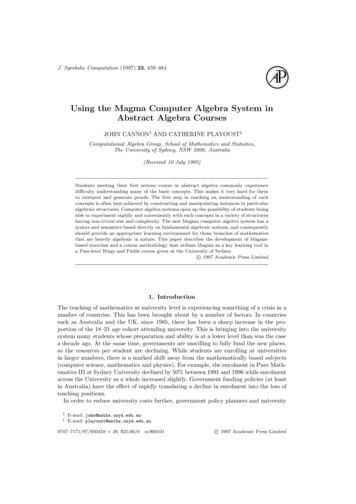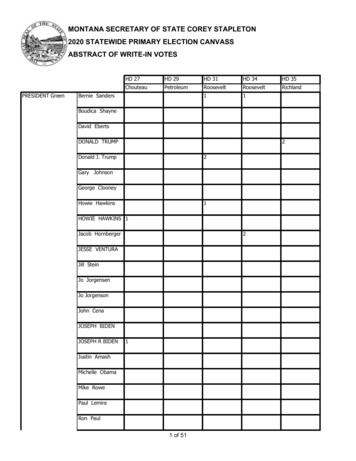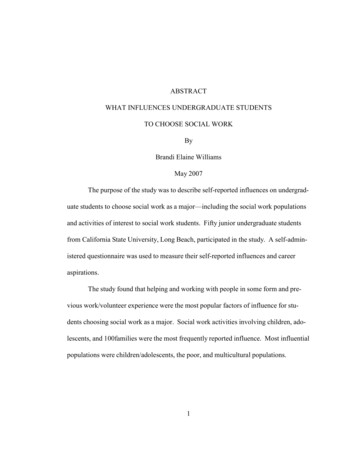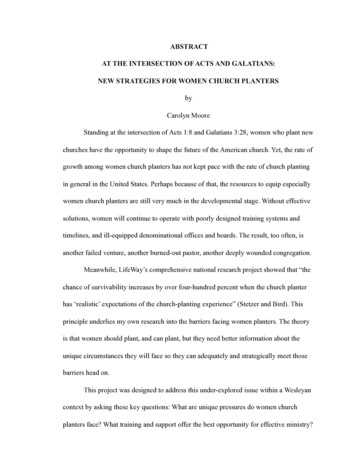
Transcription
ABSTRACTAT THE INTERSECTION OF ACTS AND GALATIANS:NEW STRATEGIES FOR WOMEN CHURCH PLANTERSbyCarolyn MooreStanding at the intersection of Acts 1:8 and Galatians 3:28, women who plant newchurches have the opportunity to shape the future of the American church. Yet, the rate ofgrowth among women church planters has not kept pace with the rate of church plantingin general in the United States. Perhaps because of that, the resources to equip especiallywomen church planters are still very much in the developmental stage. Without effectivesolutions, women will continue to operate with poorly designed training systems andtimelines, and ill-equipped denominational offices and boards. The result, too often, isanother failed venture, another burned-out pastor, another deeply wounded congregation.Meanwhile, LifeWay’s comprehensive national research project showed that “thechance of survivability increases by over four-hundred percent when the church planterhas ‘realistic’ expectations of the church-planting experience” (Stetzer and Bird). Thisprinciple underlies my own research into the barriers facing women planters. The theoryis that women should plant, and can plant, but they need better information about theunique circumstances they will face so they can adequately and strategically meet thosebarriers head on.This project was designed to address this under-explored issue within a Wesleyancontext by asking these key questions: What are unique pressures do women churchplanters face? What training and support offer the best opportunity for effective ministry?
How can female planters equip their congregational leaders to become partners inpositively influencing their community and culture? I asked these questions through theuse of an online survey tool, as well as through personal interviews with planters.The solution is in education. By training women planters about the barriers thathave the potential to hinder their success in their work, they can more realisticallyprocess the effect of these barriers on their work. They must get training in the areas ofleadership development, financial management, time management, the art of negotiation,and the recruitment of coaches and mentors, so that they are adequately equipped for thework to which they are called. Finally, denominational leaders and coaches must do theirown research so that they can constructively coach planters on the journey.
DISSERTATION APPROVALThis is to certify that the dissertation entitledAT THE INTERSECTION OF ACTS AND GALATIANS:NEW STRATEGIES FOR WOMEN CHURCH PLANTERSpresented byCarolyn Moorehas been accepted towards fulfillmentof the requirements for theDOCTOR OF MINISTRY degree atAsbury Theological SeminaryDissertation CoachDateDirector, Doctor of Ministry ProgramDateDean of the Beeson CenterDate
AT THE INTERSECTION OF ACTS AND GALATIANS:NEW STRATEGIES FOR WOMEN CHURCH PLANTERSA DissertationPresented to the Faculty ofAsbury Theological SeminaryIn Partial FulfillmentOf the Requirements for the DegreeDoctor of MinistrybyCarolyn MooreFebruary 09, 2018
ProQuest Number: 10828958 All rights reserved INFORMATION TO ALL USERSThe quality of this reproduction is dependent upon the quality of the copy submitted.In the unlikely event that the author did not send a complete manuscriptand there are missing pages, these will be noted. Also, if material had to be removed,a note will indicate the deletion. ProQuest 10828958Published by ProQuest LLC (2018 ). Copyright of the Dissertation is held by the Author. All rights reserved.This work is protected against unauthorized copying under Title 17, United States CodeMicroform Edition ProQuest LLC. ProQuest LLC.789 East Eisenhower ParkwayP.O. Box 1346Ann Arbor, MI 48106 - 1346
2018Carolyn MooreALL RIGHTS RESERVED
TABLE OF CONTENTSPageLIST OF TABLES .viiiACKNOWLEDGMENTS .xCHAPTER 1 NATURE OF THE PROJECT .1Overview of the Chapter .1Personal Introduction .1Statement of the Problem .4Purpose of the Project . 6Research Questions.6Research Question #1 .6Research Question #2 .6Research Question #3 .6Rationale for the Project .6Definition of Key Terms .10Delimitations .12Review of Relevant Literature .12Research Methodology .16Type of Research .19Participants .19Instrumentation .19Data Collection .20iii
Data Analysis .20Generalizability .20Project Overview .20CHAPTER 2 LITERATURE REVIEW FOR THE PROJECT .22Overview of the Chapter.22Biblical Foundations .22What the Bible Says About Human Design.23What the Bible Says About Men, Women and Leadership .25How Biblical Women Supported the Spread of the Gospel .29Beyond the Biblical Witness.32Women in History .32What Contemporary Women Experience in Leadership .35A Lag in Progress Among Women Leaders .39Barriers to Church Planting for Women .43The Theological Barrier.43The Perception Barrier.48Self-Image: How Women Leaders Perceive Themselves .54The Double-Bind: How Others Perceive Women Leaders .59The Resource Barrier .62The Benchmark Barrier .64The Pastoral Care Barrier .65The Biological Barrier .67iv
Research Design Literature .68Summary of Literature .71CHAPTER 3 RESEARCH METHODOLOGY FOR THE PROJECT .76Overview of the Chapter.76Nature and Purpose of the Project .77Type of Research .77Research Questions.78Research Question #1 .78Research Question #2 .81Research Question #3 .82Ministry Context(s).82Participants .83Criteria for Selection .83Description of Participants .86Ethical Considerations .86Instrumentation .87Pilot Test or Expert Review (optional) .88Reliability & Validity of Project Design .88Data Collection .90Data Analysis .93CHAPTER 4 EVIDENCE FOR THE PROJECT.95iv
Overview of the Chapter .95Profile of the Survey Participants .96Profile of the Church Planter Interview Participants .99Profile of the Church Development Director Interview Participants .100Research Questions.101Research Question #1: Description of Evidence .102Research Question #2: Description of Evidence .125Research Question #3: Description of Evidence .142Summary of Major Findings .148CHAPTER 5 LEARNING REPORT FOR THE PROJECT .152Overview of the Chapter .153Major Findings .154Empowerment Through Education . 154Empowerment Through Equipping. 157Empowerment Through Partnership . 161Ministry Implications of the Findings .162Limitations of the Study .163Unexpected Observations .164Recommendations .169Conclusion .120Postscript .171vi
APPENDIXESA. Consent Form for Dissertation Research .175B. Online Survey Questions for Female Church Planters .176C. Expert Review Demographic Data Instrument .182D. Phone Interview with Church Planters .185E. Conference Call Focus Group with Denominational Leaders .186WORKS CITED .188WORKS CONSULTED .200vii
LIST OF TABLESPageTable 4.1. Age of survey respondents at the time of planting .97Table 4.2. Length of time serving in church plant .98Table 4.3. Time served/ average weekly worship attendance/ kind of plant .100Table 4.4. Frequency of personal conversation about women in church planting .103Table 4.5. Frequency of others’ conversations about women in leadership .104Table 4.6. Reasons why women planters do not have coaches. 110Table 4.7. Percentage of planters given goals/ Percentage of planters who met goals. 114Table 4.8.Women who had children at home while service as a pastor. 117Table 4.9. Ages of survey participants .121Table 4.10. How mid-life emotions affect ministry .122Table 4.11. How nurturing pastors consider themselves to be toward others .124Table 4.12. How confident are you in carrying out your ministry?.127Table 4.13. How confident are you that you carry the authority of leadership among yourpeople? .127Table 4.14. Is your title ever an issue or topic of conversation? .129Table 4.15. Which sentence best describes you in this season? .129Table 4.16. Perceived leadership style of respondents .132Table 4.17. Have you used a professional coach or consultant? .135Table 4.18. Hours worked per week .140Table 5.1. In ministry, is your gender ever an issue for you or those around you? .164viii
Table 5.1. How likely is it in your opinion that your ministry is negatively affected byyour gender? .165iv
ACKNOWLEDGMENTSThis study is done to the glory of God; with deepest appreciation for the goodpeople of Mosaic Church, who have loved me well and taught me daily what it means tobe the Church; with heartfelt love for Steve, Claire Marie and Pierce, who have supportedthis call to ministry so generously; and in memory of Helenor Davisson, a female circuitrider in the early Methodist movement who became the first woman to be ordained in theformer Methodist Protestant Church, predecessor to The United Methodist Church in theUnited States.x
CHAPTER 1Overview of the ChapterThe work of starting a new church is challenging for the best among pastors.Doing so without the right tools and context is a recipe for discouragement and will meanfailure for some. In this work, women planters especially must be eyes-wide-open to thegender-based differences that can create natural barriers to success. These differencesmust be acknowledged and addressed in order for women to succeed as planters. Thepurpose of this chapter is to introduce the experience of one female church planter, thebarriers she encountered and the questions with which she now wrestles. An argument ismade for further study of the experiences of women planters to discover what barriersthey faced and what possible accommodations might make the best of a pastor’s efforts.The goal of this project is to help women church planters increase their chances formoving past the barriers faced by many so they can successfully plant and grow athriving church.Personal IntroductionI am beginning to think it was actually a sign from God.I found it on the church sign standing in front of The Holy House of Prayer ofJesus Christ. At the end of a string of other announcements about repenting and whereyou can find them on the radio, the sign read, "God have [sic] never called a woman topreach. Never will.” The sign stood in front of a little building with burglar bars, deep inone of the most impoverished areas of Georgia (known as Frog Holler or Bethlehem), indowntown Augusta, Georgia.1
I will admit that the day I found it, I delighted in that sign. Things like thatvalidate my experience of being a woman in ministry in the South. A remarkable amountof prejudice still exists around the issue women in spiritual leadership, I don't hear it inevery conversation, but I will admit that over time I have developed more of a suspicionabout people's motives. I have had enough conversations with others in my church toknow they debate their friends and co-workers regularly on this issue. They defend theirchurch and their pastor admirably. I wish they did not have to, but I am grateful beyondwords for their convictions.I wonder how many people I will never meet, how many opportunities I willnever even know I missed, because the people I might have known do not trust my placeas a pastor. I have taken way too much time reflecting on this concern. The inequalityexposes something broken in me. I feel trapped. I get angry, defensive. I obsess. I findmyself talking about it far too often, with far too much passion. I go beyond good sense.Because I am irrationally competitive, I have a hard time making peace with the realitiesof life, and this becomes a problem. These are the frustrations many women face in thequest to plant churches. How can women lead past the barriers inherent in ministry sothey can plant successfully?Ten years ago, I moved to Evans, Georgia (part of Augusta) with my husband anddaughter to plant a United Methodist church. We were a parachute drop; Mosaic began inour home and moved to an office complex before settling in a school auditorium. Webegan worshiping weekly in 2004 and our average attendance today is 200. Our membersare mostly working class. The typical person at Mosaic lives on the margins of suburbanlife. Half the women in our church (literally half) are single, most of them with multiple2
dependent children. We are also home to young families struggling to make ends meetand single adults with addiction issues. We have worked to develop healthy leaders fromamong those whom God has sent into our community and God has been slowly, quietly,faithfully building us up. Our peo
Asbury Theological Seminary Dissertation Coach Date Director, Doctor of Ministry Program Date Dean of the Beeson Center Date . AT THE INTERSECTION OF ACTS AND GALATIANS: NEW STRATEGIES FOR WOMEN CHURCH PLANTERS A Dissertation Presented to the Faculty of Asbury Theological Seminary .
